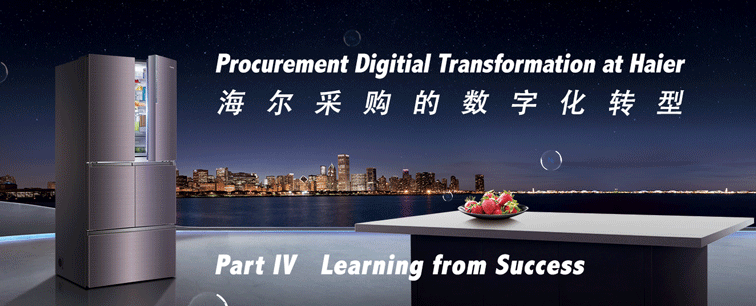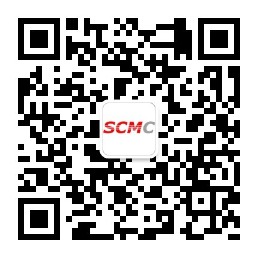
written by: Tony Wai, President, SCMC Ltd.
Procurement transformation at Haier started from supporting the main business strategies that’s consistently customer focused. Digital technology platform has always been a mean for an end to strengthen competitiveness through improved costs, efficiency, supplier performance, innovation, agility and transparency. The journey showed us some insight on success factors for digital transformation at functional level in a large enterprise.
We summarized the success pillars as follows:
- Align with strategic direction from the top
- Driven by customer focused business transformation
- Engaged and benefiting stakeholders
- Motivation system that favors the new paradigm
- Mindset that embrace change and learning
- Invest, adopt and take ownership of technology
1. Top-down alignment
Procurement has been in direct respond to strategic initiatives from the top at Haier from the very beginning and at every stage of Haier’s strategic development, going through multiple phases of changes in organization, policies, procedure and focus demanded by business focus. This is amplified accelerated in the background of highspeed economic development era in China where enterprise evolution time was highly compressed compared to matured economies. “Zhang Ruimin has been keeping a clear focus on customer value and experience during all these times of strategic development. This is reflected in every way in our organization structure, policy and practice”, a former-employee from Haier said.
2. Microenterprise supports new paradigm
The microenterprise organization structure model was created by Zhang’s vision of Rendanheyi, a Chinese term meaning “aligning employee interest and customer orders”, which has become the company’s fundamental principle of operation.
Widely studied and shared at top business schools such as Harvard and Walton, and attracted thousands of companies to visit and learn at Haier, the microenterprise model effectively converted a traditional corporate structure into a federation of entrepreneurial venture start-ups. Fortune Magazine wrote: “Many CEOs call their employees associates; others call them partners. Zhang calls all 73,000 of them entrepreneurs—and actually means it…… It’s one sign of how Zhang is changing his company, the world’s No. 1 appliance maker”.
This top-down organization redesign started to take place in 2008. Microenterprises, or virtual business units with full profit and loss ownership, and with financial performance tying directly to employees’ compensation were formed cross-functionally. They make their own business decisions, attract funding, hire and fire employees autonomously, distribute profit and manage asset, and even makes external investment decisions.
3. Motivation for Customer Value Focus
The microenterprise structure highly aligned customer focus at the ground level, encouraged solutions best aligned with customer demand and corporate interest, as it provided great incentive for employee for self-value actualization though this. This has numerous implications:
- Employees are transformed from workers that executes tasks from a command chain to business owners. Every employee now sees a broader, holistic picture of his/her job at a higher business level, creative intelligence is awakened
- The autonomy has transformed the company from a closed system to an open system, broke up and penetrated all functional “silos”, encouraged information free flow that readily connects stakeholders to the outside world, increased sensitivity to customer preference, creativities, competitions and quickened adoption of innovative solution from supply chain.
- Customers are turned into life time user from a one-time customer as people on the ground has stronger incentive to promote customer loyalty. Organization objective is transformed to providing solution for users and improve satisfaction rather than one-off business deal.
4. Engaged Stakeholders
Stakeholder within microenterprise is allowed for autonomous business decision making at the product level, supporting agile response to market changes, enabling the business unit to quickly pilot their approach, product, function, aesthetics, pricing or strategy to seize new market opportunities that create value for consumers, at their own discretion. This lays an important foundation that both impacted procurement model and enabled for transformation.
Traditional procurement function has now become a service center to microenterprises, with supply management professionals separately joining the microenterprises as an integral part of the microenterprise team members to directly support the autonomous business, facilitating among suppliers, customers and internal stakeholders. The Haidayuan digital platform plays a key role in supporting this perfect hybrid model of centralized volume leverage with open, transparent process and distributed buying decision making, giving internal stakeholders an active role to directly engage and interact with suppliers, benefiting to maximize their own value from a holistic picture.
5. Skills, Mindset and Willingness
As we see from Haier’s journey, digital transformation is not a one step process. It’s an ongoing journey that takes advantage of new technology to leap ahead or at least maintain competitive advantage. Digital transformation requires corresponding skills in the operation team that are able to understand use of technology and the consequential process change at the beginning, and goes on to demand the capability to envision new model of working that creates more business impacts leveraging new technologies, with further development and evolution of a digital system. Concepts such as analytics, modeling, algorithm, optimization, multiple data source integration, and blockchain adds to the list of desire knowledges that builds the foundation to rein in adapting digital technology effectively.
Similar to other companies, Haier lacks the necessary skills initially. External consulting service was brought in to help set strategic direction and offer suggestions for skills development. Haier’s “can do” culture drives a growing mindset internally, propelling their employees to adapt and progress through a fast changing era, and developed skills along the way. Old habit and fixed mindset are gradually replaced by more dynamic new bloods through regeneration of workforce and redesign of organization. An enabled, thinking, and accountable workforce has far more willingness to challenge the quota and innovate processes. Digital skills and mindset for procurement team is built via working side-by-side with IT team to continuously develop and improve the Haidayuan system over the years.
6. Adopt and take ownership of technology
In the old way, as in most current corporate cases, IT is usually an internal service unit that owns and manages software development outsourcing. System applications are developed by external provider, and upgrades released in months or even years periodically.
Although the initial plan for the Haidayuan platform was to outsource software development similar to this fashion, Haier procurement quickly learned that technology must be in its own control in order to tightly integrate the development of perpetual process transformation and quickly pilot new concepts. As soon as the technical architect is complete with basic version 1.0 functions, software development was converted to in-house, collocating with the procurement, working alongside with a dedicated process and platform team in the organization.
Functional ownership of the digital platform has engaged stakeholders and suppliers better, quicken respond to change, enabled better control on optimizing integration of resources and data, and faster adaptation of new technologies. For business that are pushing the envelope at the frontier such as Haier, taking ownership of technology rather than relying on an external 3rdparty also means processes stay proprietary and maintaining better competitive edge.
Success Formula
Although organizations vary in size and nature, the success factors found in Haier’s transformation can be the right formula for any case. Mindset for change and willingness to embrace technology are particularly important. People tend to resist change due to uncertainty and fear, the “known” always feels safe. To many, technology has always been a different domain an require “expertise” to deal with. Yet today, technology is intertwined and fully integrated in our job and life, becoming the usual “paper and pencil” that you need as basic. Transformational change is perpetual and accelerating whether you like it nor not, pushed from various direction: market, competition, supplier, management, regulations, geopolitics, trade environment, etc., caused by technology disruption. The right mindset and culture helps an organization stay ahead of the competitions.
- 还没有人评论,欢迎说说您的想法!



